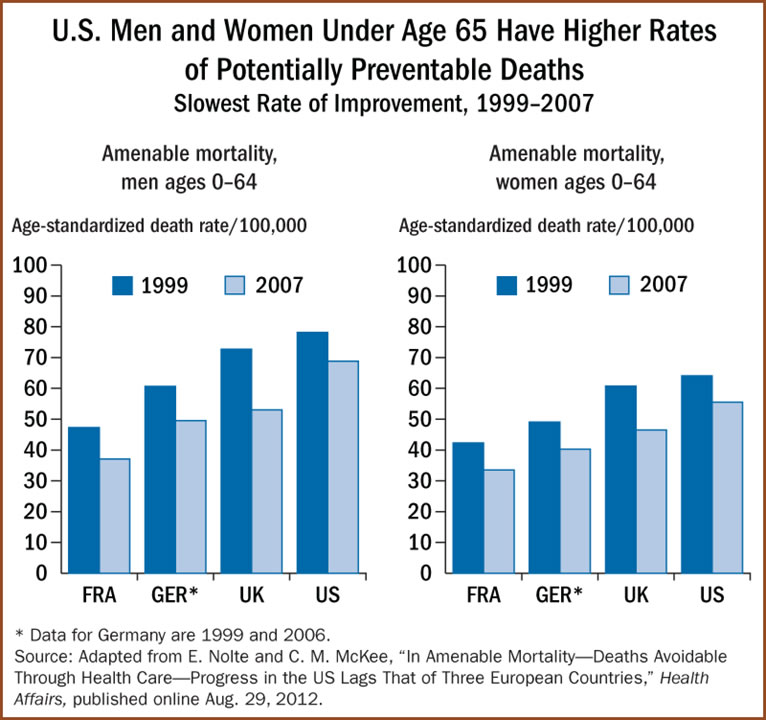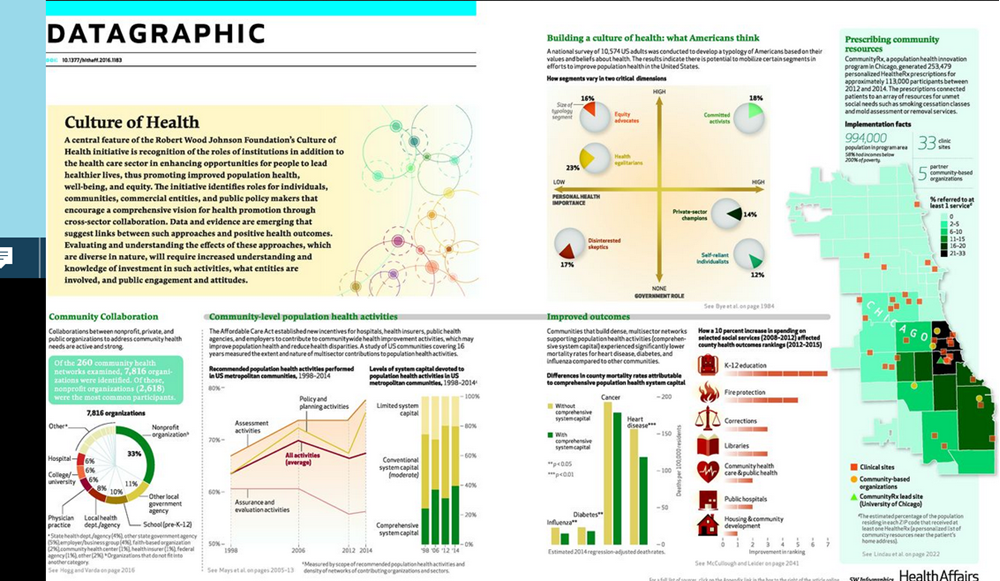

Concept
Over the last 50 years chronic diseases have replaced infectious diseases as the major diseases affecting the population and the health care system in the US, and globally. Read this review from the Lancet for an overview of chronic diseases in the US with particular attention to the "key messages" box, as well as this Viewpoint from JAMA.
Keywords
Primary prevention, secondary prevention, surveillance, registers, aging, personal behaviors.
Definitions
Primary prevention: a program of activities directed at improving general well-being while also involving specific protection for selected diseases, such as immunization against measles, and control to prevent hypertension and hyperlipidemia on the way to preventing coronary disease and stroke.
Secondary prevention: a level of preventive medicine that focuses on early diagnosis, use of referral services, and rapid initiation of treatment to stop or modify the progress of disease processes or a handicapping disability, such as insect and coronary disease, transient ischemic attacks, and type II diabetes..
Objectives
At the conclusion of this session students should be able to:
Prevention
The centers for disease control and prevention has as one of its major focuses chronic disease prevention and health promotion. Look at the major programs of this segment of the agency. Click on the top left link, in the 6 box list, labeled "Chronic Diseases and Health Promotion" and consider that chronic diseases is now the leading cause of death and disability in the US. Review the changes in death rates over the last 100 years as well as life expectancy changes After looking at these tables think about what major changes occurred in the medical treatment environment in the 1940s and 1950s that significantly changed causes of death between the early 1900s and the early 2000s. Think about Alexander Fleming when considering the single change in treatment that occurred during this period and led to today's chronic disease epidemic. Think about the fact that when you don't die from one thing you will die from something else.. Read the CDC's power of prevention (pages 2-13) which summarizes current progress in chronic disease intervention as well as CDC's policies and plans. Take a look at this viewpoint on use of health care dollars.
Scan my Essay on the topic, only the health promotion section, stopping when you get to the section on environmental issues
Return to the home page of CDC's chronic disease prevention and promotion program and click on the statistics and tracking link. Become familiar with the major tracking systems used by the CDC with a particular emphasis on the BRFSS and youth risk behavior surveillance system surveys. There is concern among many people in the public health field, both in the US and other countries, that unnecessary concerns over privacy has limited the development of disease "registries" which could help us better determine the value of various interventions in controlling these diseases ,with attention to use of registries, (see article from Lancet (top of page). At present the only major registries found in the United States at the national and state levels are cancer registries. Some individual states have begun to use diabetes registries. Also look at the following graphic and consider the contents as you review the rest of the session (remember the low place of the US health care "system" vs... those of other developed countries).

Go to the chronic disease Community Health Status Pages. Select Virginia ( or home state) and your county/city of residence and look at data for chronic disease. On the county/city page look at the three tabs at the top and view each of then, then consider how well you think the various states are doing in controlling chronic disease. Click on some of the other links (you may find CDC has broken ones) it is worth checking out ones you might be interested in. An increasing concern, as many people look more closely at the determinants of health found in Healthy People 2020, is the disparity among income and racial groups, although the latter may be more a function of income, as seen on the Health Equity page in chronic disease program at CDC. Think about the session on community assessment and my paper on socioeconomic differences that was published in 1972, one of the first papers which now would be labelled an issue on health equity (although this paper focussed on economic differences by census tract rather than race). Such concerns date back to the poor laws of England in the 1800s where the increased prevalence of disease among poor people was noted. We still fail to focus on some the major underlying determinants of poor health such as poor health education in schools. Consider why the cost of preventive medicine exams differ across states and counties, there have been no changes since the publication of this story 3 years ago. Take a look at the Virginia Board of Health's position on Chronic Disease Control (pdf). Now scan this recent document from the King's Fund on the role of changing behaviors responsible for many chronic diseases and consider whether this information regarding the UK also applies to the USA. Note that in the New England Journal of Medicine (1968) Lester Breslow and Anne Summers published the first major review on the effect of behaviors on death, at this time in men, noting that 5 or 6 behaviors resulted in loss of 11 years of life. It takes a long time for obvious to sinking to a medical and public psyche. With make wasted much of the 50 years since this publication could have been preventing the majority of chronic diseases.
Take a look at the world health organization's web page on chronic diseases (Click on the infographics link in the 2nd paragraph) and the message from the director of WHO, then go to the web page on chronic diseases and health promotion and look at the special areas prevention and management at the bottom of the page. Also look at the Lancet Editorial on Global CD prevention. Now look at the IOM's review of decision-making to minimize CD in developing countries and consider how this also applies to many parts of the USA - read the introduction (page 16-20).
Scan this publication of the Institute of Medicine, living well with chronic illness. Read the Forward (pages 10-11), then read the abstract (on pages 16- 18) and scan the summary (on pages 20 through 38 (I have highlighted the important issues)). Also read the JAMA paper on multiple morbidity as it applies to chronic diseases particularly in light of the continued concern for the current epidemic of CD in the USA. This feature from the WSJ suggests where we may be in the future. It is worth looking at the weight other countries deal with chronic diseases, smoking for instance. Look at this presentation from the UK's N HS on quitting smoking.
Note that the session on genetics placed an increasing emphasis on the rapidly developing epidemic of chronic disease, as will the session on primary care where we discuss concern about chronic disease giving rise to the need for team-based care as response to failure to control the early stages in development of chronic diseases.
In the Sept. 2015 issue of the Journal "Heath Affairs" look at the editorial on the growing burden, and the article on Three Decades of Global Data.
The June 11 issue of JAMA has two great articles, one is a viewpoint and the other is an editorial on the continuing role of obesity and its relationship to all chronic diseases, as and as such the need to reduce its prevalence.
Think about the importance of developing a culture that focuses on health of the individuals as well as the population. Take a look at this data graphic from the Journal Health Affairs from November 2016 to begin thinking about this topic. You can also read the second article in this journal use the TML online library which is directly related to the issue,

Finally, go to the Chronic Disease and Translational Research course, select one of the topics and review the PowerPoint slide show attached and consider how much new information the Slide Show gave you about epidemiology and/or interventions. Scan this recent paper on the possible effect of the Microbiome on chronic disease.